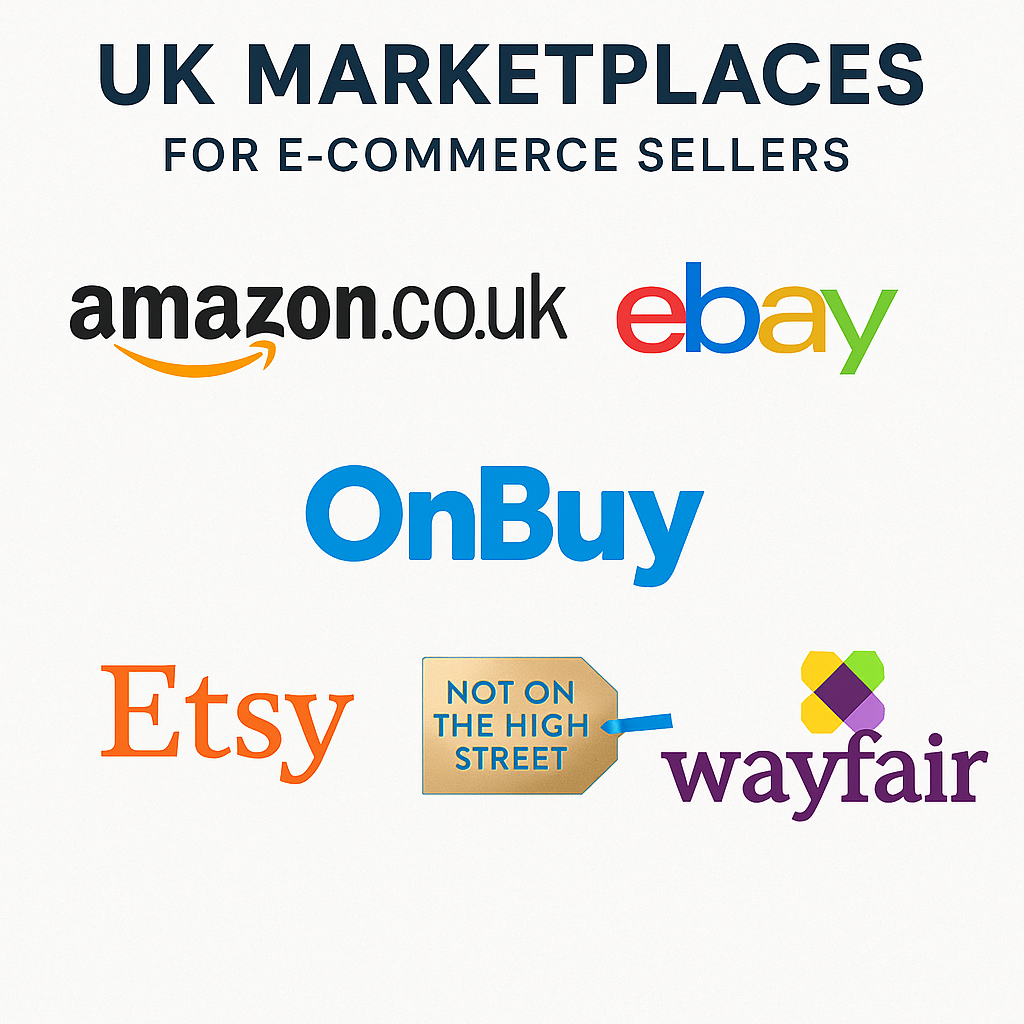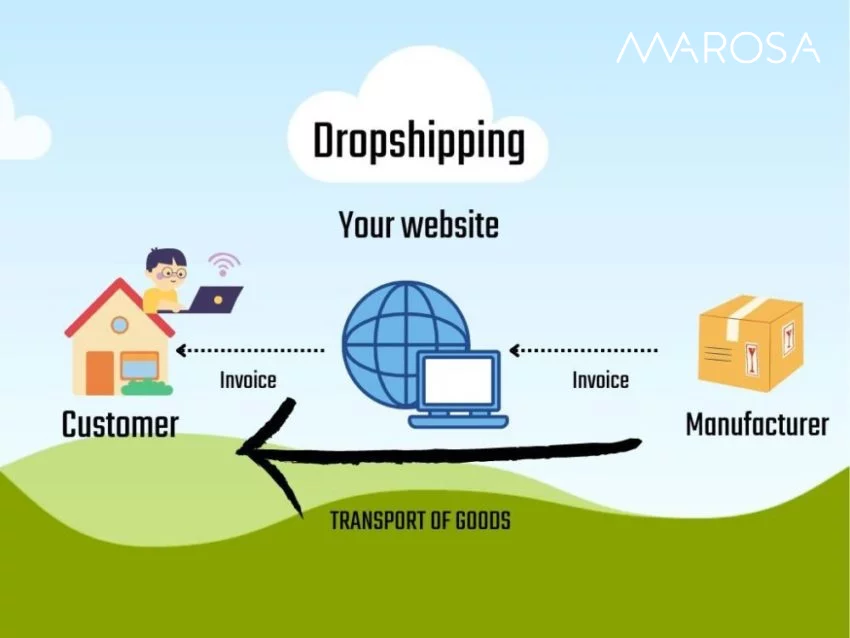Some key trends to keep in mind:
- Amazon UK draws 400+ million monthly visits according to recent data, making it a powerhouse for UK e-commerce traffic.
- eBay remains a strong competitor, with traffic levels reaching roughly 70–75% of Amazon’s in the UK market.
- A growing number of niche & local marketplaces are emerging, enabling sellers to reach audiences with more targeted interests (homeware, handmade, fashion, artisan goods, etc.).
With that in mind, here are eight of the most promising marketplace channels currently (or soon to be) relevant to UK sellers — along with their strengths, challenges, and tips for success.
1. Amazon UK
Why it’s promising
- Massive scale and reach — ideal for generalist and well-stocked sellers.
- Fulfillment by Amazon (FBA) and multi-channel fulfillment make logistics simpler.
- High buyer trust and a large base of repeat customers.
Challenges and considerations
- Intense competition and price pressure.
- Fees (fulfillment, referral, storage) can eat into margins.
- Brand differentiation can be harder (unless you invest in branding, A+ content, etc.).
Tips for success
- Use FBA for prime eligibility and faster delivery.
- Focus on winning the Buy Box.
- Optimize listings (keywords, images, A+ content).
- Monitor inventory and avoid “stockouts,” which hurt rankings.
2. eBay UK
Why it’s promising
- Flexible selling models: auctions, “Buy It Now,” fixed-price listings.
- Lower barrier to entry; ideal for smaller, niche, or second-hand products.
- Strong buyer protection and trust in the platform.
Challenges and considerations
- It may not always support premium brand positioning (for new/refurbished items).
- Listing fees, final value fees, and optional upgrade costs.
- Need to manage customer expectations (shipping times, returns).
Tips for success
- Use a mix of auction and fixed listings to test pricing.
- Ensure excellent seller ratings — they drive buyer confidence.
- Use strong photography and clear product descriptions.
- Experiment with promoted listings for extra visibility.
3. Etsy (UK + global reach for crafted / artisan goods)
Why it’s promising
- Strong demand for handmade, vintage, low-volume, artisan goods.
- Loyal community of buyers who appreciate craftsmanship and uniqueness.
- Easy to open a store and begin without heavy setup or bulk inventory.
Challenges and considerations
- It’s not the best fit for mass-produced goods or commodities.
- Listing & transaction fees (and payment processing fees) can add up.
- The marketplace is competitive — many sellers will have overlapping product styles.
Tips for success
- Tell a strong brand/story — buyers on Etsy like personal connection.
- Use SEO (titles, tags) tailored to Etsy’s search algorithm.
- Take advantage of Etsy Ads or promoted listings if you want more visibility.
- Maintain high review scores and buyer engagement.
4. Temu UK
Why it’s promising
- Temu has a rapidly growing and massive user base, offering significant exposure for sellers
- There are no initial listing or advertising fees, making it a low-risk environment for testing new products or channels
- Temu takes care of order fulfillment, including picking, packing, and shipping, freeing up seller time and resources.
- Sellers can automatically tap into global markets like the US and UK without needing a local physical presence,
Challenges and considerations
- Temu's business model relies on incredibly low prices, requiring sellers to maintain a balance between quality and price to convert customers
- Higher commisions in certain categories .
- While newer, the platform's growing popularity means competition can still be a factor,
- Sellers need to carefully manage pricing to account for shipping costs and ensure efficient fulfillment to be profitable
Tips for success
- Ensure excellent seller ratings — they drive buyer confidence.
- Use strong photography and clear product descriptions.
- Experiment with promoted listings for extra visibility.
5. TikTok UK
Why it’s promising
- TikTok has a vast user base that spends significant time on the platform, providing a huge potential market and opportunities for high engagement
- TikTok's algorithm can surface products to interested users on their "For You Page," leading to more organic product discovery than on traditional search-based platforms
- Content can gain immense visibility and attract millions of views and potential customers, regardless of a seller's follower count.
- The platform makes it easy to collaborate with influencers and affiliates, leveraging their trusted voices to promote products and boost sale
- TikTok Shop allows customers to discover, evaluate, and purchase products directly within the app, streamlining the buying process
- The platform's focus on entertaining, authentic video content can create urgency and drive immediate, impulse sales.
- Setting up a TikTok Seller account is straightforward and free, making it easy to get started with minimal technical experience.
Challenges and considerations
- Success on TikTok depends heavily on a constant output of fresh, engaging video content. This can be time-consuming and expensive to produce consistently, especially when compared to traditional e-commerce platforms
- The platform's popularity has led to a saturated market. To stand out, sellers must produce creative and attention-grabbing content, which requires significant time and effort
- Sales are often driven by viral content, which is unpredictable and short-lived. This makes it difficult to build a stable, long-term sales strategy based solely on organic reach
- Despite high visibility, many brands report that converting views into actual sales can be challenging. Many users are on the app for entertainment and are not always in a shopping mindset.
Tips for success
- Ensure excellent seller ratings — they drive buyer confidence.
- Use strong photography and clear product descriptions.
- Experiment with promoted listings for extra visibility.
6. OnBuy (UK-based alternative to Amazon/eBay)
Why it’s promising
- UK-based and oriented toward supporting sellers (not competing with them).
- Lower commission and more seller-friendly policies in many cases.
- Growing in awareness as an alternative to the bigger platforms.
Challenges and considerations
- Traffic is smaller than Amazon/eBay, so you’ll need to market your listings actively.
- Less mature in terms of advanced tools, third-party integrations, etc.
- Some product categories might underperform due to niche or lower demand.
Tips for success
- Position your products thoughtfully (unique selling points, niche appeal).
- Use OnBuy alongside other marketplaces — don’t rely on it exclusively.
- Monitor commission and fees to ensure your pricing remains viable.
7. Not On The High Street (NOTHS) & Curated Marketplaces
Why it’s promising
- Focus on unique, giftable, artisan, or niche products.
- Buyers come expecting higher quality, distinctiveness, and premium products.
- Lower competition in many niches (compared to generalist marketplaces).
Challenges and considerations
- Selective acceptance criteria; not everyone can list.
- Fees and commissions may be higher in exchange for curation and better audience fit.
- Volume may be lower, so your product margins need to support that.
Tips for success
- Apply only with your best, most differentiated SKU(s).
- Emphasize the “story behind the product” — craftsmanship, sustainability, design.
- Manage stock carefully — out-of-stock hurts credibility.
- Use cross-channel promotion to drive traffic to your listings there.
8. Niche & Specialty Marketplaces (Fashion, Home, DIY, etc.)
Some of these include:
- Wayfair / ManoMano , B&Q (home, furniture, DIY) — useful if your inventory aligns with home, furnishings, garden, tools.
- Tesco, Debnams, ASOS Marketplace / Zalando / fashion-marketplaces — for independent fashion labels targeting style-conscious UK/EU customers.
Why they’re promising
- Buyers on these platforms often already know what they want (less “just browsing”).
- Greater chance of niche alignment (your product fits the audience).
- Less “noise” from unrelated product categories.
Challenges and considerations
- Many are selective in approving new sellers.
- They may have stricter fulfillment, branding, or packaging standards.
- The audience might be more discerning — you’ll need quality, brand, and consistency.
Tips for success
- Match your product lines closely to the marketplace’s focus.
- Be prepared for stricter review, return, and quality control processes.





